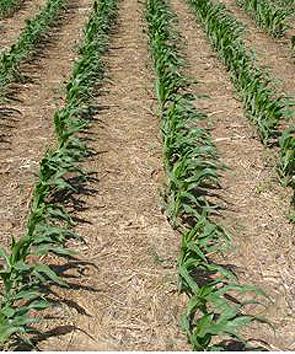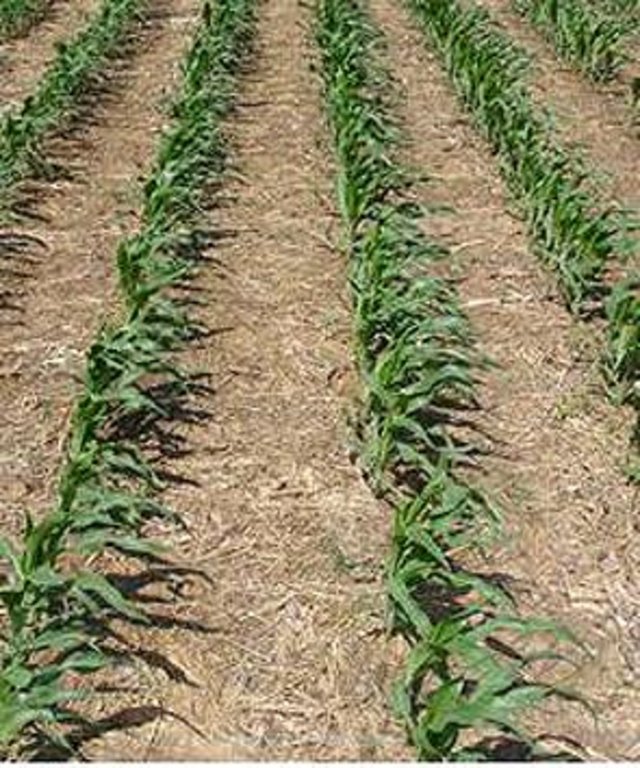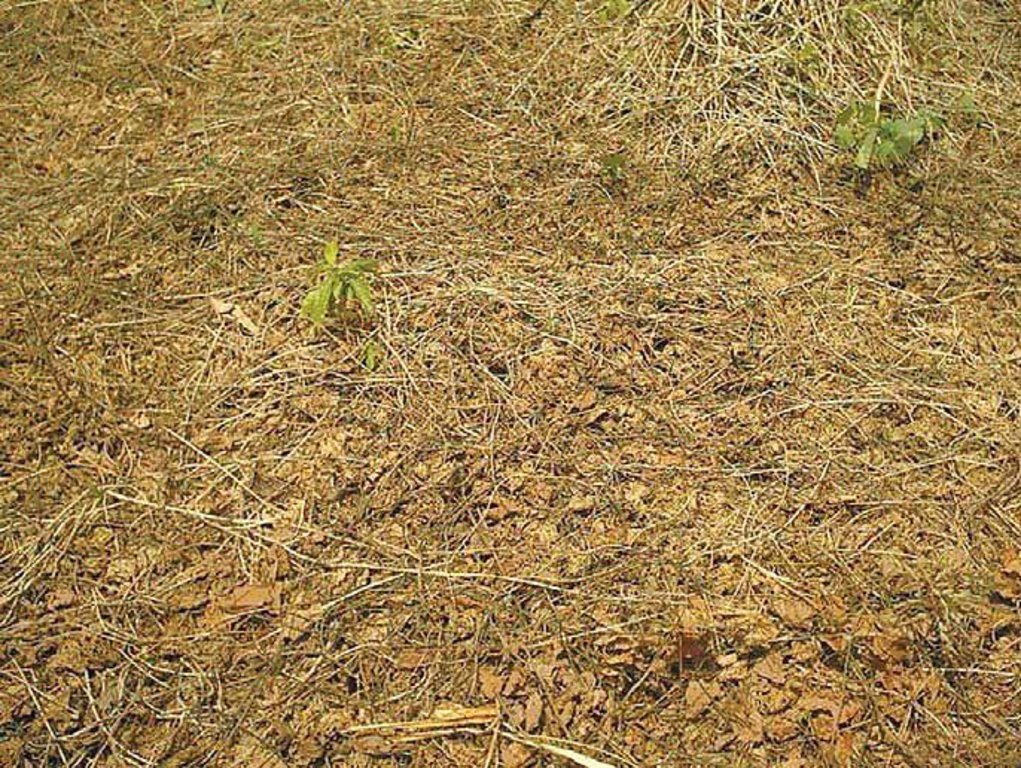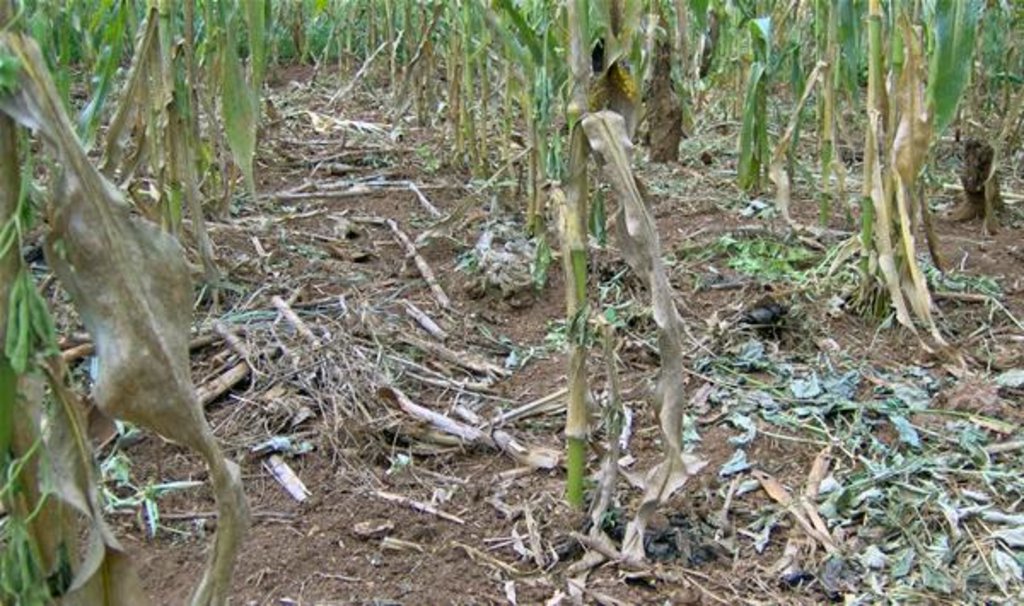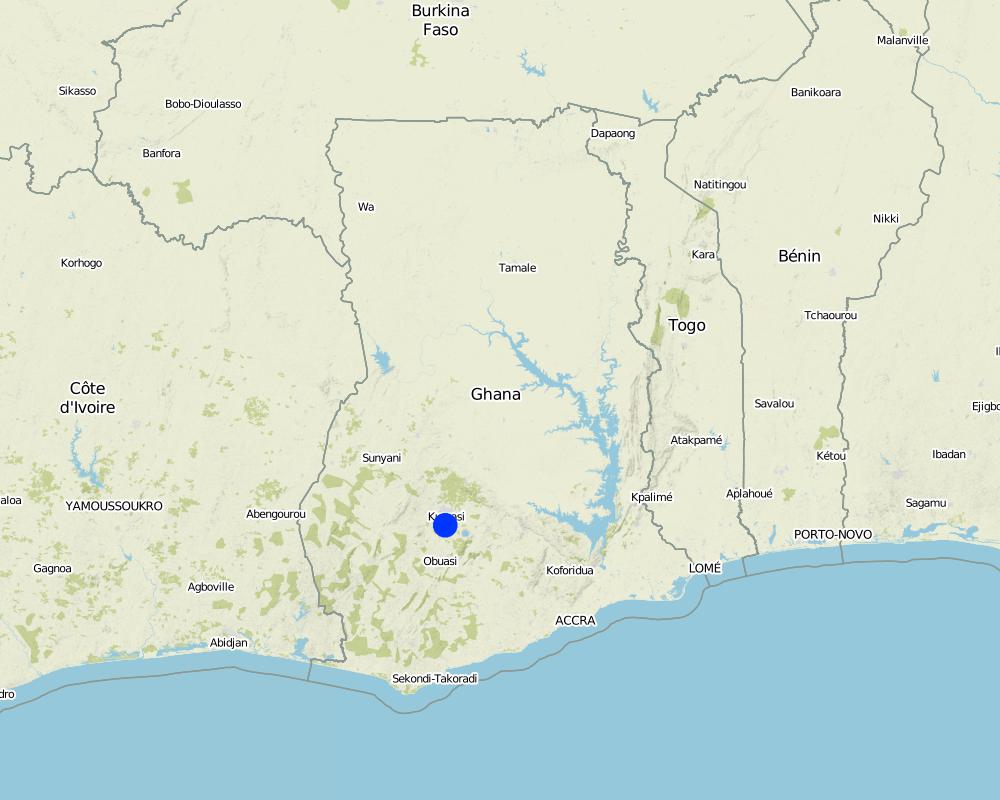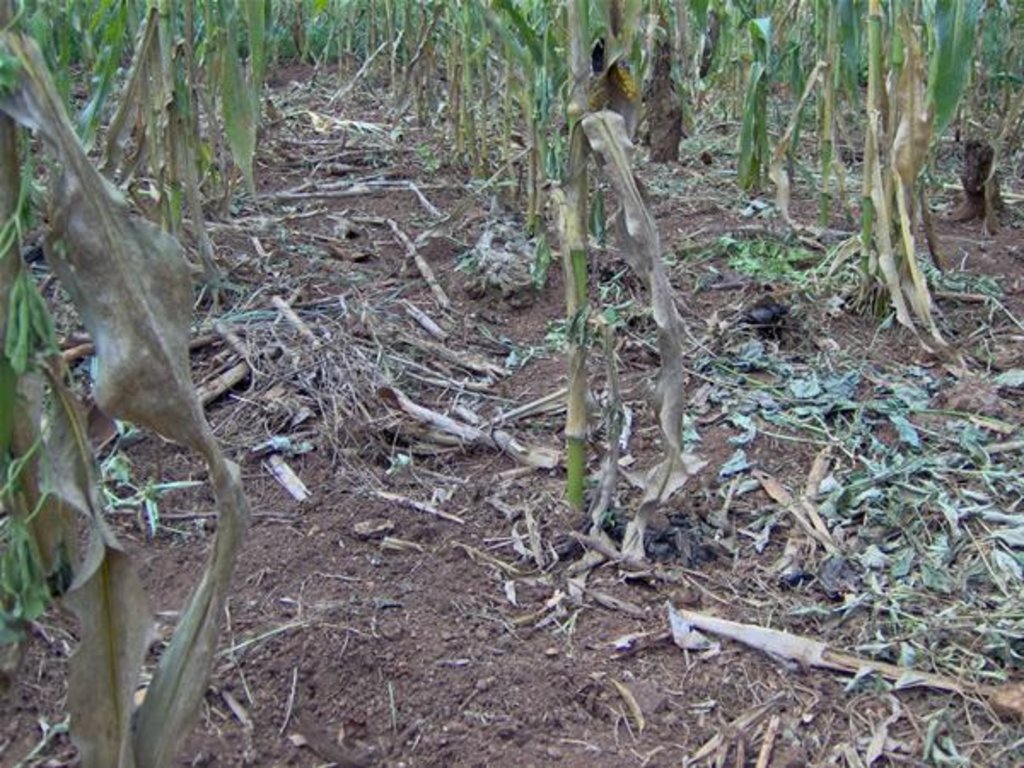Minimum Tillage and Direct Planting [Gana]
- Criação:
- Atualização:
- Compilador/a: Unknown User
- Editor: –
- Revisores: Fabian Ottiger, Alexandra Gavilano
technologies_1329 - Gana
Veja as seções
Expandir tudo Recolher tudo1. Informação geral
1.2 Detalhes do contato das pessoas capacitadas e instituições envolvidas na avaliação e documentação da tecnologia
Pessoa(s) capacitada(s)
Especialista em GST:
Adjimon Souroudjaye
Volta Environmental Conservation Organization
Gana
Nome do projeto que facilitou a documentação/avaliação da Tecnologia (se relevante)
Book project: SLM in Practice - Guidelines and Best Practices for Sub-Saharan Africa (SLM in Practice)1.3 Condições em relação ao uso da informação documentada através de WOCAT
O/a compilador/a e a(s) pessoa(s) capacitada(s) aceitam as condições relativas ao uso de dados documentados através da WOCAT:
Sim
2. Descrição da tecnologia de GST
2.1 Descrição curta da tecnologia
Definição da tecnologia:
Minimum tillage and direct planting are two conservation agriculture practices which basically consist of leaving crop residues on the soil surface without burning and subsequent planting through the mulch.
2.2 Descrição detalhada da tecnologia
Descrição:
The traditional slash-and-burn land use system in the case study area – involving clearing natural vegetation followed by 2-5 years of cropping – has become unsustainable as land pressure has greatly increased, shortening fallow periods. Under the SLM practice of ‘minimum tillage and direct planting’, land is prepared by slashing the existing vegetation and allowing regrowth up to 30 cm height. A glyphosate-based round-up herbicide (Round-up, Chemosate or Helosate) is sprayed with a knapsack fitted with a low-volume nozzle. The residue is left on the soil surface without burning. After 7–10 days, direct planting is carried out in rows through the mulch. Maize is the main crop planted under this system. Planting is practiced manually using a planting stick.
Purpose of the Technology: The mulch layer has several important functions: it helps to increase and maintain water stored in the soil, reduces soil erosion, contributes to improve soil fertility (after crop residues have decomposed in subsequent seasons) and it efficiently controls weeds by hindering their growth and preventing weeds from producing seeds. The use of herbicides requires adequate knowledge. An even better option is to introduce multipurpose cover crops to control weed populations, improve soil fertility, and enhance yields while diversifying crop production and thus reducing dependence on the use of herbicides. Labour inputs for land preparation and weeding is considerably decreased under conservation agriculture. Women benefit most from the workload reduction since these time-consuming activities are their task. For men, the new technology usually means heavier work, especially during the 1st year, since they have to plant through the mulch. Using a jab planter makes the work easier
Establishment / maintenance activities and inputs: Minimum tillage and direct planting includes the following recurrent activities: 1. Initial land clearing: slash existing vegetation and allow regrowth (up to 30 cm); before onset of rains season.
2. Spraying of pre-emergence herbicide; 300 ml (2 sachets) for every 15 litres water for annual weeds; 450 ml (3 sachets) for every 15 litres water for perennial weeds.
3. Leave residues on the soil surface without burning.
4. Planting through the mulch.
5. Spraying post-emergence herbicide; after regrowth of weeds (7-10 days after planting).
6. Harvesting.
All activities are carried out manually (each cropping season) using jap planter (or a planting stick) and knapsack sprayers.
Natural / human environment: Both case study areas fall within the wet semi-equatorial zone of Ghana with a mean monthly temperature of between 23 °C and 33 °C (SDA 1995). Rainfall is bimodal in both districts with a peak rainy season from the end of March to July and again from September to November, after a short dry spell in August. In general soil characteristics in the study areas vary from well drained with high organic matter content in the forest area, to poorly drained with low organic matter content in the savannah belt.
2.3 Fotos da tecnologia
2.5 País/região/locais onde a tecnologia foi aplicada e que estão cobertos nesta avaliação
País:
Gana
Região/Estado/Província:
Brong Ahafo Region
Especificação adicional de localização:
Sunyani and Atwima district
Map
×2.6 Data da implementação
Caso o ano exato seja desconhecido, indique a data aproximada:
- 10-50 anos atrás
2.7 Introdução da tecnologia
Especifique como a tecnologia foi introduzida:
- durante experiências/ pesquisa
Comentários (tipos de projeto, etc.):
early 1990s
3. Classificação da tecnologia de GST
3.1 Principal/principais finalidade(s) da tecnologia
- Melhora a produção
- Reduz, previne, recupera a degradação do solo
- Adaptar a mudanças climáticas/extremos e seus impactos
- Criar impacto econômico benéfico
3.2 Tipo(s) atualizado(s) de uso da terra onde a tecnologia foi aplicada

Terra de cultivo
- Cultura anual
Cultivo anual - Especificar culturas:
- cereais - milho
Comentários:
Major land use problems (land users’ perception): Fertility decline and reduced organic matter, water erosion, destruction of vegetation trough fires
3.5 Grupo de GST ao qual pertence a tecnologia
- Solo/cobertura vegetal melhorada
- Perturbação mínima ao solo
3.6 Medidas de GST contendo a tecnologia

Medidas agronômicas
- A1: cobertura vegetal/do solo

Medidas de gestão
- M2: Mudança de gestão/nível de intensidade
Comentários:
Main measures: agronomic measures
Secondary measures: management measures
3.7 Principais tipos de degradação da terra abordados pela tecnologia

Erosão do solo pela água
- Wt: Perda do solo superficial/erosão de superfície

Deteriorização química do solo
- Cn: declínio de fertilidade e teor reduzido de matéria orgânica (não causado pela erosão)

Degradação biológica
- Bq: quantidade/ declínio da biomassa
- Bf: efeitos prejudiciais de incêndios
Comentários:
Main type of degradation addressed: Wt: loss of topsoil / surface erosion, Cn: fertility decline and reduced organic matter content
Secondary types of degradation addressed: Bq: quantity / biomass decline, Bf: detrimental effects of fires
Main causes of degradation: soil management, population pressure, land tenure
3.8 Redução, prevenção ou recuperação da degradação do solo
Especifique o objetivo da tecnologia em relação a degradação da terra:
- Prevenir degradação do solo
- Reduzir a degradação do solo
4. Especificações técnicas, implementação de atividades, entradas e custos
4.1 Desenho técnico da tecnologia
Especificações técnicas (relacionada ao desenho técnico):
Residue management on a field with mature maize plants
Technical knowledge required for field staff / advisors: moderate
Technical knowledge required for land users: moderate
Main technical functions: control of raindrop splash, improvement of ground cover, increase in organic matter, increase in nutrient availability (supply, recycling,…), increase / maintain water stored in soil
Autor:
Souroudjaye Adjimon, Volta Environmental Conservation Organization, Ghana
4.3 Atividades de implantação
| Atividade | Periodicidade (estação do ano) | |
|---|---|---|
| 1. | Purchase jab planter | |
| 2. | Purchase herbicides | |
| 3. | Purchase knapsack |
4.4 Custos e entradas necessárias para a implantação
| Especifique a entrada | Unidade | Quantidade | Custos por unidade | Custos totais por entrada | % dos custos arcados pelos usuários da terra | |
|---|---|---|---|---|---|---|
| Equipamento | Tools | ha | 1,0 | 70,0 | 70,0 | 100,0 |
| Custos totais para a implantação da tecnologia | 70,0 | |||||
| Custos totais para o estabelecimento da Tecnologia em USD | 70,0 | |||||
Comentários:
Remarks: Input costs include Jab planter US$ 20; herbicides US$ 5-6/liter. A knapsack costs US$ 50, which not affordable for small-scale farmers (they have to get organised in groups, or hire spraying gangs). Comparing to the traditional slash-and-burn system, Minimum tillage and direct planting has increased inputs costs but reduced labour costs and higher yields, which makes the conversion profitable!
4.5 Atividades recorrentes/manutenção
| Atividade | Periodicidade/frequência | |
|---|---|---|
| 1. | Initial land clearing: slash existing vegetation and allow regrowth (up to 30 cm) | before onset of rainy season |
| 2. | Spraying of pre-emergence herbicide; 300 ml (2 sachets) for every 15 litres water for annual weeds; 450 ml (3 sachets) for every 15 litres water for perennial weeds | |
| 3. | Leave residues on the soil surface without burning | |
| 4. | Planting through the mulch | |
| 5. | Spraying post-emergence herbicide; after regrowth of weeds | 7-10 days after planting |
4.6 Custos e entradas necessárias pata a manutenção/atividades recorrentes (por ano)
| Especifique a entrada | Unidade | Quantidade | Custos por unidade | Custos totais por entrada | % dos custos arcados pelos usuários da terra | |
|---|---|---|---|---|---|---|
| Mão-de-obra | Labour | ha | 1,0 | 83,0 | 83,0 | 100,0 |
| Equipamento | Tools | ha | 1,0 | 18,0 | 18,0 | |
| Fertilizantes e biocidas | Herbicides | ha | 1,0 | 110,0 | 110,0 | |
| Custos totais para a manutenção da tecnologia | 211,0 | |||||
| Custos totais de manutenção da Tecnologia em USD | 211,0 | |||||
Comentários:
Machinery/ tools: jap planter, knapsack sprayer
4.7 Fatores mais importantes que afetam os custos
Descreva os fatores mais determinantes que afetam os custos:
Costs for herbicides and spraying equipment are the most determinant factor affecting the costs. Comparing to the traditional slash-and-burn system, Minimum tillage and direct planting has increased inputs costs but reduced labour costs and higher yields, which makes the conversion profitable!
5. Ambiente natural e humano
5.1 Clima
Precipitação pluviométrica anual
- <250 mm
- 251-500 mm
- 501-750 mm
- 751-1.000 mm
- 1.001-1.500 mm
- 1.501-2.000 mm
- 2.001-3.000 mm
- 3.001-4.000 mm
- > 4.000 mm
Especificações/comentários sobre a pluviosidade:
1400-1850 mm, bimodal
Zona agroclimática
- Subúmido
Thermal climate class: tropics
5.2 Topografia
Declividade média:
- Plano (0-2%)
- Suave ondulado (3-5%)
- Ondulado (6-10%)
- Moderadamente ondulado (11-15%)
- Forte ondulado (16-30%)
- Montanhoso (31-60%)
- Escarpado (>60%)
Formas de relevo:
- Planalto/planície
- Cumes
- Encosta de serra
- Encosta de morro
- Sopés
- Fundos de vale
Zona de altitude:
- 0-100 m s.n.m.
- 101-500 m s.n.m.
- 501-1.000 m s.n.m.
- 1.001-1.500 m s.n.m.
- 1.501-2.000 m s.n.m.
- 2.001-2.500 m s.n.m.
- 2.501-3.000 m s.n.m.
- 3.001-4.000 m s.n.m.
- > 4.000 m s.n.m.
Comentários e outras especificações sobre a topografia:
Altitudinal zone: 101-500 m a.s.l. (220-380 m a.s.l.)
5.3 Solos
Profundidade do solo em média:
- Muito raso (0-20 cm)
- Raso (21-50 cm)
- Moderadamente profundo (51-80 cm)
- Profundo (81-120 cm)
- Muito profundo (>120 cm)
Matéria orgânica do solo superficial:
- Alto (>3%)
- Baixo (<1%)
Caso disponível anexe a descrição completa do solo ou especifique as informações disponíveis, p. ex. tipo de solo, PH/acidez do solo, nitrogênio, capacidade de troca catiônica, salinidade, etc.
Topsoil organic matter: High (forest area) and low (savannah area)
Soil drainage/infiltration: High (forest area) and low (savannah area)
5.5 Biodiversidade
Diversidade de espécies:
- Alto
5.6 Características dos usuários da terra que utilizam a tecnologia
Orientação de mercado do sistema de produção:
- Subsistência (autoabastecimento)
- misto (subsistência/comercial)
Nível relativo de riqueza:
- Pobre
Indivíduos ou grupos:
- Indivíduo/unidade familiar
Nível de mecanização:
- Trabalho manual
Gênero:
- Mulheres
- Homens
Indique outras características relevantes dos usuários da terra:
Population density: 100-200 persons/km2
100% of the land users are poor.
5.7 Área média de terrenos utilizados pelos usuários de terrenos que aplicam a Tecnologia
- < 0,5 ha
- 0,5-1 ha
- 1-2 ha
- 2-5 ha
- 5-15 ha
- 15-50 ha
- 50-100 ha
- 100-500 ha
- 500-1.000 ha
- 1.000-10.000 ha
- > 10.000 ha
É considerado pequena, média ou grande escala (referente ao contexto local)?
- Pequena escala
5.8 Propriedade de terra, direitos de uso da terra e de uso da água
Propriedade da terra:
- Comunitário/rural
- Indivíduo, intitulado
Direitos do uso da terra:
- Arrendado
- Indivíduo
6. Impactos e declarações finais
6.1 Impactos no local mostrados pela tecnologia
Impactos socioeconômicos
Produção
Produção agrícola
Quantidade anterior à GST:
0.75-1 t
Quantidade posterior à GST:
3t / ha
Renda e custos
Despesas com insumos agrícolas
Comentários/especificar:
Only input costs are higher than for slash and burn, but labour costs are reduced
Rendimento agrícola
Quantidade anterior à GST:
50 US
Quantidade posterior à GST:
123 US
Carga de trabalho
Quantidade anterior à GST:
83
Quantidade posterior à GST:
48
Comentários/especificar:
Critical labour shortage at weeding time is avoided, increased labour constraints only in the first year
Outros impactos socioeconômicos
Possibility of early planting
Comentários/especificar:
Benefit from early rains, due to minimal land prep.
Impactos socioculturais
Estado de saúde
Comentários/especificar:
Might occur if no proper handling of herbicides is ensured
Situação de grupos social e economicamente desfavorecidos
Comentários/especificar:
Women / children benefit most from workload reduction
Impactos ecológicos
Ciclo hídrico/escoamento
Colheita/recolhimento de água
Solo
Umidade do solo
Cobertura do solo
Perda de solo
6.3 Exposição e sensibilidade da tecnologia às mudanças climáticas graduais e extremos/desastres relacionados ao clima (conforme o ponto de vista dos usuários da terra)
Mudança climática gradual
Mudança climática gradual
| Estação do ano | aumento ou diminuição | Como a tecnologia lida com isso? | |
|---|---|---|---|
| Temperatura anual | aumento | bem |
Extremos (desastres) relacionados ao clima
Desastres meteorológicos
| Como a tecnologia lida com isso? | |
|---|---|
| Temporal local | bem |
| Tempestade de vento local | não conhecido |
Desastres climatológicos
| Como a tecnologia lida com isso? | |
|---|---|
| Seca | bem |
Desastres hidrológicos
| Como a tecnologia lida com isso? | |
|---|---|
| Inundação geral (rio) | não conhecido |
Outras consequências relacionadas ao clima
Outras consequências relacionadas ao clima
| Como a tecnologia lida com isso? | |
|---|---|
| Período de crescimento reduzido | bem |
Comentários:
The technology is tolerant to climatic extremes, contrary to the traditional slash-and-burn practice
6.4 Análise do custo-benefício
Como os benefícios se comparam aos custos recorrentes/de manutenção(do ponto de vista dos usuários da terra)?
Retornos a curto prazo:
neutro/balanceado
Retornos a longo prazo:
positivo
6.5 Adoção da tecnologia
Se disponível, determine a quantidade (número de unidades familiares e/ou área abordada):
193 households and 100% of the area covered
De todos aqueles que adotaram a Tecnologia, quantos o fizeram espontaneamente, ou seja, sem receber nenhum incentivo/ pagamento material?
- 11-50%
Comentários:
88% of land user families have adopted the Technology with external material support
170 land user families have adopted the Technology with external material support
12% of land user families have adopted the Technology without any external material support
23 land user families have adopted the Technology without any external material support
There is no trend towards spontaneous adoption of the Technology
Comments on adoption trend: 30% of farmers ceased conservation farming practices after termination of projects input. 21 communities with 193 farmers (125 male, 68 female) apply the technology in the case study area (totally 2845 km2). Around 88% accepted the technology receiving incentives. There is little trend towards spontaneous adoption (through cross farmer visits); 30% of farmers ceased conservation farming practices after termination of projects input
6.7 Pontos fortes/vantagens/oportunidades da tecnologia
| Pontos fortes/vantagens/oportunidades na visão do/a compilador/a ou de outra pessoa capacitada |
|---|
| Increased crop yield |
| Increased farm income |
6.8 Pontos fracos, desvantagens/riscos da tecnologia e formas de superá-los
| Pontos fracos/desvantagens/riscos na visão do usuário da terra | Como eles podem ser superados? |
|---|---|
| High amounts of soil cover impeded germination of the main crop, thereby affecting productivity | partial burning appeared necessary in such cases to reduce the quantity of mulch on the field |
| Fields that had been ploughed for years recorded slightly lower yield with minimal tillage and herbicide application, probably due to ploughing pan formation (hindering root penetration) | ripping |
| Pontos fracos/vantagens/riscos na visão do/a compilador/a ou de outra pessoa capacitada | Como eles podem ser superados? |
|---|---|
| Knowledge/experience is needed for adequate application of herbicides and handling of jab planters | training/advisory service |
| Increased expenses and dependence on herbicides | introduce multipurpose cover crops to control weed populations, improve soil fertility, and enhance yields while diversifying crop production |
| Availability of / access to herbicides and equipment is limited; some dealers sell adulterated or fake products that are harmful to the environment | hire spraying gangs; provide training; set up rent-a-knapsack |
| Increased labour constraints in the first year; need for a long term investment | good rates of return are achieved in the 2nd year of continuous use of the technology; long term user rights are crucial |
7. Referências e links
7.2 Referências às publicações disponíveis
Título, autor, ano, ISBN:
Boahen P, B.A. Dartey, G.D. Dogbe, E. A. Boadi, B. Triomphe, S. Daamgard-Larsen, J. Ashburner. 2007. Conservation agriculture as practised in Ghana. Nairobi. African Conservation Tillage Network. FAO.
Disponível de onde? Custos?
FAO
Links e módulos
Expandir tudo Recolher tudoLinks
Não há links
Módulos
Não há módulos


